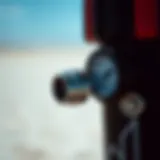Understanding Liquid Force Foil Wings in Kiteboarding
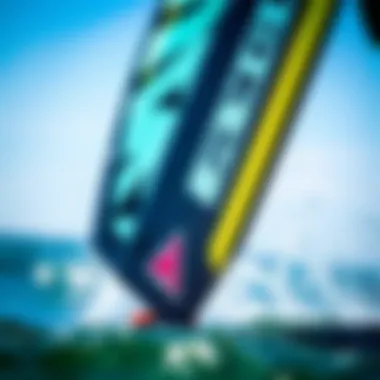
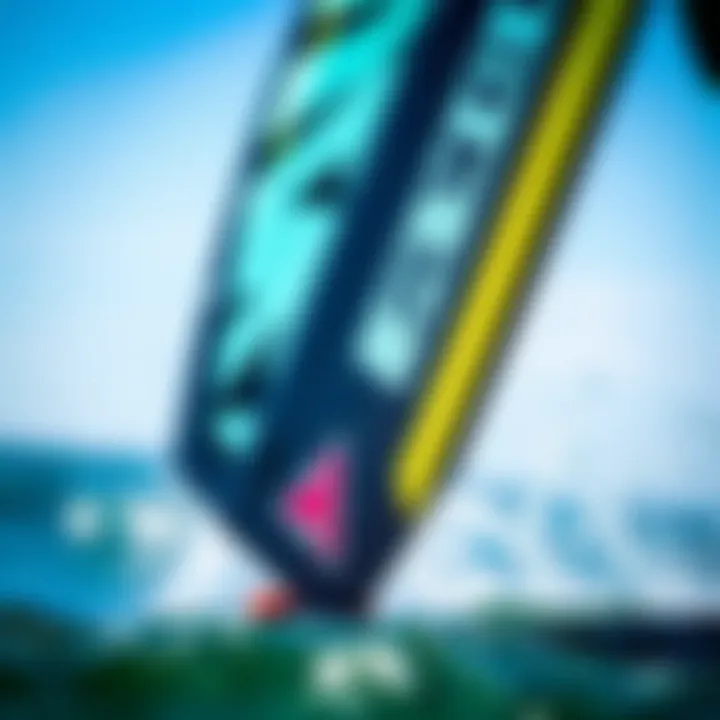
Intro
Kiteboarding has evolved significantly over the years, with advancements in technology pushing the boundaries of performance and rider experience. Among these innovations, Liquid Force foil wings have gained popularity for their unique ability to create lift above the water surface. This artcle explores the intricacies of these wings and how they can transform the way kiteboarders interact with their environment. From their design and construction to their impact on riding techniques, understanding foil wings opens new avenues for both seasoned experts and those just beginning their kiteboarding journey.
By examining the distinctive features of Liquid Force foil wings, along with the practical benefits and challenges associated with them, this article aims to furnish enthusiasts with a deeper knowledge base. Notably, understanding how hydrofoil technology works can enhance one's crafting of riding experiences that were previously unimaginable. Thus, let's embark on a journey through the world of kiteboarding and uncover the dynamics of Liquid Force foil wings.
Intro to Kiteboarding and Foil Technology
Kiteboarding, often seen as the harmonious dance between wind and water, has come a long way since its humble beginnings. The sport involves riding on a small board while being pulled by a kite, requiring a good measure of balance, skill, and connection with nature. At its core, kiteboarding is about harnessing the power of the wind to glide across water, and as such, understanding the technologies behind it—including the innovations brought by foil wings—is essential for both enthusiasts and athletes.
Foil technology, in particular, has revolutionized how riders experience this thrilling sport. Traditional kiteboarding has its own charm, but foiling takes it to another level. Liquid Force, a major player in this domain, has developed advanced foil wings that change the game entirely. These wings lift riders above the water's surface, reducing drag significantly and allowing for higher speeds and maneuverability.
Key Elements of Kiteboarding and Foil Technology
When talking about kiteboarding and foil technology, there are pivotal aspects worth noticing. Firstly, the nature of lift and drag generated by the wings plays a crucial role in performance. Unlike typical kites that rely solely on the power of the wind to propel, foil wings provide an aerial lift that transforms the dynamics of the ride.
Secondly, the design and construction of these wings demand a deep understanding of hydrodynamics. Each curve, material choice, and construction technique contributes to how effectively the wing interacts with the water. This knowledge is invaluable not just for manufacturers but for riders who wish to optimize their performance.
Finally, safety is paramount in any extreme sport. The new technology provides both advantages and challenges. Riders must be aware of how to handle their equipment to avoid injuries.
"In this ever-evolving landscape of kiteboarding, understanding the intersection of design and performance signals to riders not just greater possibilities but also the responsibility to adapt to new challenges."
Benefits and Considerations
Kiteboarders and adventure enthusiasts alike will find foil wings attractive due to their advantages over traditional kites. Riders can explore diverse wind conditions effectively, achieving greater speeds with less power. However, along with the benefits, there are considerations to keep in mind.
- Learning Curve: While foil wings can enhance performance, they also require adaptation in techniques. Newcomers may initially find them tricky to master but can reap the rewards of improvement over time.
- Equipment Choice: Selecting the right wing is integral. Riders need to consider factors such as size, aspect ratio, and material, which will influence their experience.
- Safety Practices: As riders venture higher with the aid of foil wings, they should also be informed about the risks that come with that altitude—understanding wind patterns, water conditions and proper fall techniques can prevent accidents.
In summary, grasping the ins and outs of kiteboarding and foil technology is vital. Liquid Force's innovations exemplify the advancements that shape modern kiteboarding, pushing boundaries while ensuring that safety and performance remain at the forefront.
Liquid Force: A Leader in Kiteboarding Equipment
Liquid Force stands out as a trailblazer in the kiteboarding equipment industry, known for its dedication to quality and innovation. For kiteboarders, the choice in equipment can significantly alter both their performance and enjoyment on the water. Liquid Force doesn’t just supply gear; it creates a connection between rider and ocean, enhancing the overall experience through advanced designs and engineering. Their focus on making the sport more accessible while pushing the boundaries of performance has established them as a frontrunner.
Company Background and Innovations
Founded in the early 1990s, Liquid Force began as a small company focused on wakeboards and quickly expanded into kiteboarding, responding to the growing demand for high-quality gear in the sport. Their mission has always centered around providing riders with superior equipment that enhances performance and enjoyment. Over the years, Liquid Force has introduced numerous innovations that have set benchmarks in the industry.
Some key highlights include:
- Carbon Fiber Technology: Incorporating carbon materials in their designs to reduce weight while maintaining strength.
- Adaptive Wing Shapes: A pioneering approach to wing designs that enables riders to adapt to varying wind conditions and improve performance.
- Eco-Friendly Initiatives: A commitment to sustainability, using materials and manufacturing processes that minimize environmental impact.
These advancements are not just marketing ploys; they reflect a deeper understanding of the forces at play in kiteboarding, which is crucial for both beginners and experienced riders alike.
Focus on Foil Wing Design
The design of Liquid Force foil wings is particularly noteworthy. These wings have been meticulously crafted to maximize lift and minimize drag, enabling kiteboarders to glide effortlessly above the water’s surface. This fluidity in movement is pivotal for optimizing speed and control.
- Shape and Size Variability: Liquid Force offers a range of wing sizes tailored to different styles and skill levels. From small, agile wings for high-performance thrill seekers to larger, more stable designs suitable for newcomers, there’s something for everyone.
- Innovative Profiles: The aerodynamic profiles used in the construction of Liquid Force foil wings are a result of extensive research into hydrodynamics. Riders experience a smoother ride, feeling less resistance and more responsiveness.
- Customizable Features: Many of their designs allow for customization, letting riders adjust settings to match their specific riding conditions and preferences. This feature encourages experimentation and growth among kiteboarders.
"Choosing the right foil wing can make or break your kiteboarding adventure. Liquid Force consistently delivers options that cater to both newcomers and seasoned riders."
Overall, Liquid Force’s dedication to innovation and design excellence positions them at the forefront of kiteboarding equipment. Their foil wings not only improve performance but also foster a greater enjoyment of the sport, encouraging riders to push their limits and explore new horizons on the water.
Construction and Materials of Liquid Force Foil Wings
The construction and materials of Liquid Force foil wings play a crucial role in defining their performance and longevity. Understanding what goes into these wings not only helps consumers make informed purchasing decisions but also enhances their overall kiteboarding experience. This section will provide a detailed look at the material choices and construction techniques that set Liquid Force apart in the competitive kiteboarding market.
Analyzing Material Choices
Liquid Force utilizes cutting-edge materials, ensuring that their foil wings are both lightweight and durable. A major element worth noting is the high-modulus carbon fiber. This material not only decreases the weight significantly but also increases stiffness. When you find yourself ripping through the waves, the last thing you want is a wing that compromises your speed due to flex. Carbon fiber handles pressure exceptionally well, allowing riders to perform better in various conditions.
Another popular choice is aluminum, which is typically used for the wing masts and fuselages. Aluminum offers a good balance between weight and strength, delivering a robust structure that can withstand hard landings. The corrosion-resistant properties of certain aluminum alloys also contribute to the longevity of the wings, making them ideal for saltwater environments. A combination of these materials can result in enhanced performance because they adapt well across various wind conditions.
Moreover, Liquid Force pays attention to the finishing materials. They often use specialized coatings that improve durability and resistance to scratches and impacts. Riders shouldn’t overlook how a well-finished wing can extend its lifespan, especially when it repeatedly encounters saltwater and rough handling.
"Material matters. Lightweight wings handle better and last longer, both crucial for peak performance on the water."
Wing Construction Techniques
Wing construction techniques have come a long way from the early days of kiteboarding. Liquid Force employs advanced manufacturing processes to achieve optimal designs. One prominent technique they use is prepreg technology. This method involves creating composite laminates by impregnating fibers with a resin before layering, ensuring consistent quality. The results are uniformly strong wings that maintain their integrity even under the toughest conditions.
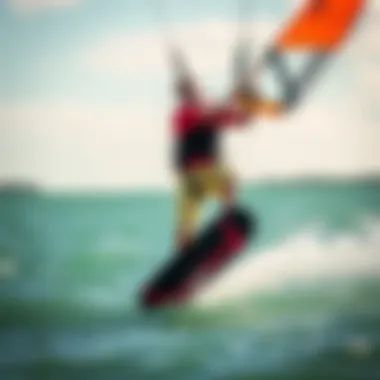
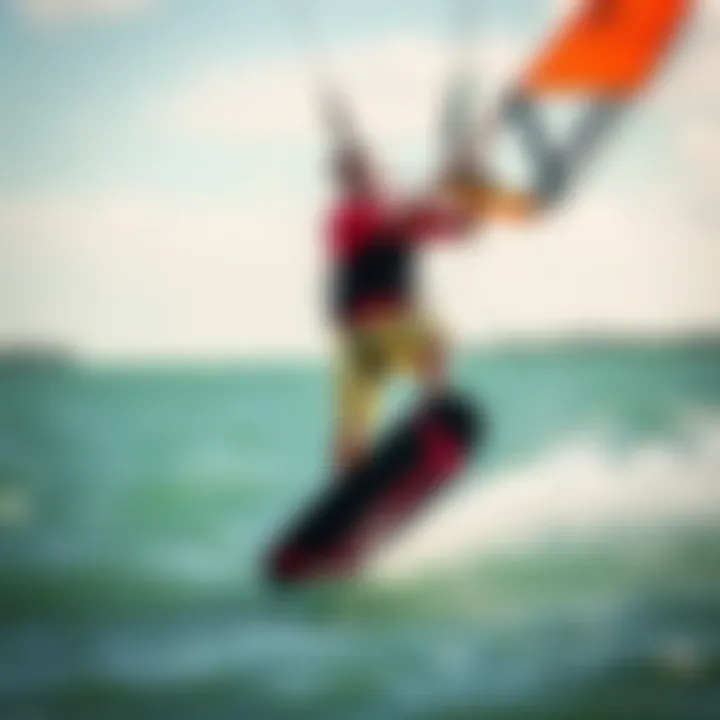
Another noteworthy technique is vacuum bagging, employed to ensure that resin distributes evenly throughout the wing. With this process, excess resin is removed, resulting in a lighter and stronger wing. It’s akin to squeezing out air from a sponge—you get a much denser and superior structure.
In terms of attachment methods, Liquid Force employs structural bonding, which combines strength and flexibility without additional weight. In this process, the bonding agents used are engineered to expand and contract with temperature changes, preventing cracks or failures over time. The interplay of these construction methods results in wings that perform beautifully and amplify the rider's connection to the water.
Hydrodynamics: The Science Behind Foil Wings
Hydrodynamics plays a pivotal role in understanding how foil wings operate in the kiteboarding milieu. At its core, hydrodynamics examines how water interacts with solid objects—in this case, the foil wings designed by Liquid Force. These wings are not just crafted for aesthetics but are ingeniously engineered to maximize performance on the water. The principles governing lift, drag, and other fluid dynamics concepts are essential for kiteboarders who aim to elevate their riding experience.
A fundamental aspect of hydrodynamics is lift. This concept refers to the upward force generated by the foil wing as it moves through the water. The design and angle of the foil dictate how effectively lift can be generated. Understanding this allows riders to optimize their speed and maneuverability. A foil wing that is angled correctly cuts through the water efficiently, providing a buoyant experience. Conversely, if the angle is off, drag increases, preventing the board from reaching its full potential.
"Just like an airplane wing, a well-designed foil wing must balance lift and drag to ensure an efficient ride."
Another significant factor is drag, which pertains to the resistance encountered as the foil slices through the water. Effective wing design seeks to minimize drag while maximizing lift. Kiteboarders frequently underestimate how crucial the relationship between these two forces is to their overall performance. Many riders possess wings that are designed with lower drag coefficients, which helps them glide effortlessly over the surface. Choosing the right wing with favorable drag characteristics can truly make or break a ride.
Understanding Lift and Drag
When discussing lift and drag, it becomes crucial to delve into their interplay. Lift is generated primarily by the shape and angle of the foil; these features work together to create a pressure differential above and below the wing. This pressure difference is a product of Bernoulli’s principle, which states that as the speed of a fluid increases, its pressure decreases. Essentially, as the foil moves through the water, high-speed fluid flow over the wing creates lower pressure above it, generating lift.
In essence, for a kiteboarder, understanding lift means recognizing how they can manipulate their body positioning and the angle of the wing. With variable angles, riders can control the amount of lift produced, adjusting according to wind conditions. Higher angles can be advantageous in light wind, helping maintain elevation, while lower angles might increase speed in stronger conditions.
On the flip side, drag is unavoidable. It's what hinders a rider's speed, and every kiteboarder faces this adversary. Two key types of drag exist: parasitic drag, which arises from the shape and surface roughness, and induced drag, which is a byproduct of lift generation itself. For kiteboarders looking to enhance performance, it's vital to strike a balance. Riders should strive to select wings that are streamlined and effective at reducing these drag forces.
The Role of Aspect Ratio
The aspect ratio of a foil wing is another critical aspect to understand. This term refers to the ratio of the wing's span to its chord (the width of the wing) and significantly influences both lift and drag characteristics.
- High Aspect Ratio Wings: These are typically longer and narrower. While they excel in lift generation and speed, they may lack stability at lower speeds. High aspect wings are favored in conditions that call for sustained performance and efficient gliding, especially in solid wind scenarios.
- Low Aspect Ratio Wings: More compact and wider, these wings are designed for stability and maneuverability. They may not provide the same level of high-speed lift but are ideal for beginners or those who prefer a more controlled ride in choppy conditions.
Choosing the right aspect ratio often comes down to personal preference and riding style. While experienced riders may opt for a higher aspect wing to push their limits, beginners could find a lower aspect ratio wing offers the control they need to build their skills.
In summary, comprehending the hydrodynamics surrounding Liquid Force foil wings enables riders to make informed choices on equipment and riding techniques. Recognizing how lift, drag, and aspect ratio interplay unveils deeper insights into optimizing kiteboarding performance. Armed with this knowledge, enthusiasts can navigate the water like seasoned pros.
Advantages of Using Liquid Force Foil Wings
When it comes to kiteboarding, the choice of equipment plays a pivotal role in determining the experience on the water. Liquid Force foil wings are engineered with a focus on performance and user experience, setting a new standard in the sport. This section aims to illuminate the significant benefits associated with using these foil wings, emphasizing key elements that enhance a kiteboarder's ride.
Enhanced Speed and Efficiency
One of the standout attributes of Liquid Force foil wings is their ability to significantly boost speed and efficiency. Unlike traditional kites, foil wings harness the lift generated through hydrodynamic principles, allowing riders to glide smoothly over the water surface.
- Aerodynamic Design: The sleek profile of these wings minimizes drag, allowing for a more fearless ascent into higher speeds. Riders often find that they can maintain momentum even in lighter wind conditions, an advantage that traditional designs typically lack.
- Wind Utilization: With Liquid Force foil wings, riders can better exploit the available wind, gaining speed even with a subtle breeze. This capability translates to longer sessions on the water, where the joy of kiteboarding can be enjoyed without the constant need for robust wind.
"With a Liquid Force foil wing, I can harness the wind like never before, feeling the exhilaration of speed and freedom on the water!" – Experienced Kiteboarder
The efficiency of these wings is further accentuated by their lightweight construction. Made from premium materials, they allow for easy maneuverability, making it easier to execute sharp turns and tricks without losing precious speed. For kiteboarders seeking to push their limits and explore new terrains, this aspect is truly invaluable.
Stability and Control on Water
Stability and control are paramount when navigating choppy waters or gusty winds. Liquid Force foil wings offer impressive stability, contributing to a more enjoyable and confident ride. As riders glide across the water, the wings provide a steady platform that minimizes unwanted pitching and rolling.
- Confidence in Challenging Conditions: This stability is particularly beneficial in variable wind scenarios where traditional kites may struggle. Riders can maintain better control during unexpected gusts, resulting in a safer and more exhilarating experience.
- Precision Handling: The design of the foil wings facilitates precise handling, allowing riders to make quick navigation changes while retaining balance. This ease of handling encourages riders to experiment with new maneuvers, enhancing skills and overall performance.
Another noteworthy point is the comfort level that Liquid Force foil wings provide. The improved stability reduces fatigue during longer sessions, meaning riders can enjoy more time on the water without feeling worn out. Whether you’re starting out or have years of experience, having that bit of extra support can make all the difference.
In summary, the advantages of using Liquid Force foil wings manifest in increased speed and efficiency as well as exceptional stability and control. These features are essential for anyone looking to elevate their kiteboarding experience, allowing riders to push boundaries while fostering a fun and safe environment on the water.
Performance Comparison: Foil Wings vs. Traditional Kites
When diving into the world of kiteboarding, one of the most pivotal aspects to consider is the performance between foil wings and traditional kites. Both have their merits, yet they cater to different styles, conditions, and rider preferences. Understanding these dynamics is crucial, as it not only influences your overall experience on the water but also helps in selecting the right equipment. Performance comparison sheds light on how these two technologies interact with water dynamics, rider capabilities, and the surrounding environment.
Contrasting Ride Quality
The ride quality of foil wings compared to traditional kites reveals significant differences that can impact an enthusiast's decision-making. Foil wings tend to offer a smoother ride due to their unique design. For instance, as they lift out of the water, they diminish drag, which translates into a more tranquil experience. Riders may notice a sense of weightlessness, especially in lighter wind conditions, allowing for gliding across the surface with minimal interruption.
In contrast, traditional kites can provide a different kind of thrill. They allow for more direct feedback from the wind, giving riders the chance to harness gusts and power through the air more aggressively. This responsiveness can be particularly appealing for trick enthusiasts or those who crave high jumps. However, the ride can feel choppier, especially in rough conditions, as the kite remains tethered to the water.
To illustrate:
- Foil wings:
- Traditional kites:
- Gentle lift and smooth ride
- Reduced water drag
- Better performance in light winds
- Direct wind feedback
- Increased agility in tricks
- Can feel bumpy in chop

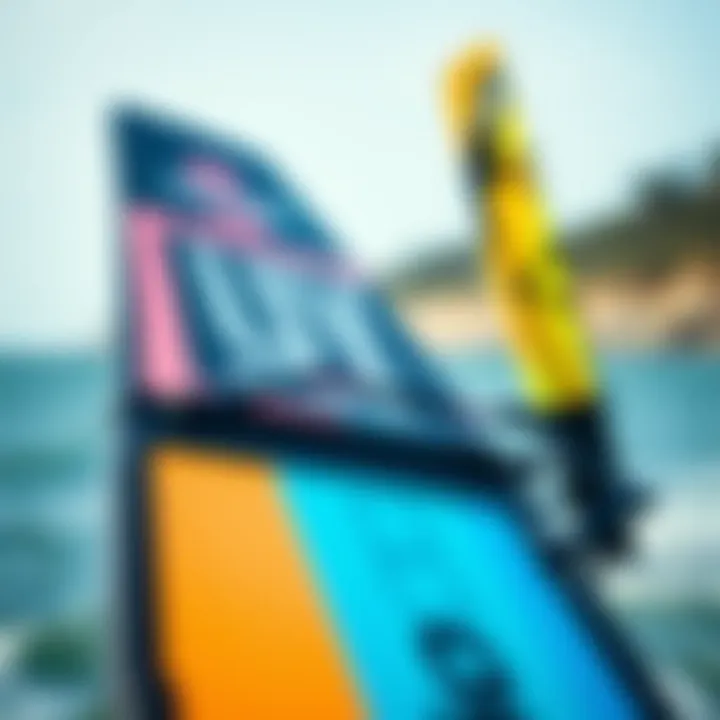
Like an artist choosing between brushes, each rider will find a style that complements their artistic expression on the water.
Wind Range and Conditions
The conditions and wind range where foil wings and traditional kites perform also contrast sharply. Foil wings excel in a broader range of wind conditions, particularly when winds are lighter. This ability to perform efficiently across low wind scenarios means that riders can enjoy sessions that might be impossible with a traditional kite setup. The enhanced lift provided by the foil significantly contributes to sustained rides without the need for powerful winds.
For example, in the 8 to 15 knot range, a foil wing can glide effectively, making it a preferred choice when exploring shallow water areas or when conditions are more fickle. Once the wind picks up beyond this range, riders may find that traditional kites take the reins, delivering robust performance and power that fuels high-speed runs and aerial tricks.
Some key considerations include:
- Foil Wings:
- Traditional Kites:
- Can handle winds of 8 knots or less
- Ideal for flat water surfaces
- Better suited for winds over 15 knots
- More control in gusty conditions
It's essential for kiteboarders to evaluate the typical wind conditions at their local spots, as this will determine which equipment will flourish.
"Selecting the right wing is like choosing the right pair of shoes; the wrong fit can make or break your performance on the field."
In summary, navigating the choice between foil wings and traditional kites comes down to understanding the nuances of ride quality and wind responsiveness. Each type has its advantages, and the informed rider will consider personal preferences and local conditions to make the best choice.
User Experience: Testimonials from Kiteboarders
When it comes to the world of kiteboarding, user experience is the bread and butter of how equipment is perceived and utilized by enthusiasts. Listening to firsthand accounts from kiteboarders—regardless of their skill level—gives vital insights into the practical applications and performance of Liquid Force foil wings. These testimonials shed light on various aspects that can help prospective buyers and users also gauge if the product suits their unique riding styles and conditions. Here are some key elements emphasized in user experiences:
- Performance Feedback: Many kiteboarders stress that performance is paramount. Riders often share their thoughts on how Liquid Force foil wings handle during different conditions—ranging from sunny skies to choppy waters. A common sentiment is the wings' ability to maintain speed, making those exhilarating rides even more thrilling.
- Ease of Use: For beginners, ease of use is often highlighted. Individuals who have switched from traditional kites to foil wings noted that the transfer was not as challenging as they expected. They often mention how quickly they adapted to the new equipment, contributing to a more enjoyable learning curve.
- Stability and Control: A lot of testimonials emphasize the stability offered by Liquid Force foil wings. Riders frequently talk about the reassuring feel of the wings as they glide over water, thus encouraging them to push their limits and try new tricks without any hesitation. This boost in confidence can make a monumental difference in their overall experience.
Beginners' Insights on Foil Wings
As novices dip their toes into the kiteboarding sea, many turn to communities and forums like Reddit for tips and insights from fellow beginners. Sharing these insights helps demystify the initial confusion surrounding foil wings.
New users often discuss how they found the Liquid Force wings forgiving during their early attempts. One example is a rider who mentioned,
"I was really nervous about my first ride. But once up on the foil, it was smoother than I thought. I felt like I was flying!"
This sentiment resonates with many new kiteboarders. They frequently note that the wings' design seems intuitively catered towards their needs—an experience that enhances their initial exploration of the sport.
Additionally, beginners often cite the importance of proper guidance and instruction when transitioning to foil wings. Several wrote about the difference it made having an experienced instructor giving them practical advice on maneuvering and balance, which they found essential in avoiding the common pitfalls of starting in the sport.
Veteran Perspectives on Performance
On the other end of the spectrum, seasoned kiteboarders provide a treasure trove of experience and detail on performance. These individuals are often looking for high-performance attributes in their gear, and they're not afraid to hold back on criticisms or praise.
Veteran kiteboarders highlight their appreciation for the advances in Liquid Force's design. One long-time rider stated,
"I've ridden various foils, and what sets Liquid Force apart is how well they balance speed with control. You can really push it hard without fearing a nosedive."
Specifics like improved lift-off speeds, responsiveness, and how they handle in variable wind conditions are common threads in their insights. Many emphasize the value of aspect ratio—a factor that closely correlates with performance, especially when engaging in high-speed maneuvers. Veterans often share anecdotes about race conditions they’ve faced, where the precision of the foil wing made a clear difference in their competitive edge.
Furthermore, they often compare their experiences on Liquid Force wings with other brands, noting how this company has consistently offered innovations that contribute to a better overall ride.
Ultimately, the insights voice a collective recognition that Liquid Force foil wings don’t just cater to any one group in the kiteboarding community. Whether you're just starting your ride or you’re already cutting through waves like a pro, the experiences shared by both beginners and veterans provide a valuable perspective on what to expect from one of the leaders in kiteboarding gear.
Safety Considerations When Using Foil Wings
When it comes to kiteboarding, safety is never something to overlook. As much as excitement fuels the thrill of gliding across the water, it's essential to keep risk factors in mind, especially when using foil wings. These wings, designed to elevate the experience of kiteboarding, also add layers of complexity to the sport. Understanding how to navigate the challenges and hazards associated with foil wings can mean the difference between a fun outing and an unfortunate incident.
Understanding Risks
The allure of cruising above the waves can sometimes lead to a false sense of security. Foil wings have a knack for soaring high and fast, but with this capability comes a distinct set of risks. For instance, the lifting force created during a ride can cause you to lose control if proper technique isn't employed. Even seasoned riders might find themselves caught off guard by unexpected gusts of wind, which can contribute to sudden changes in altitude and direction.
Moreover, collisions with other kiteboarders or onlookers can pose serious dangers. The foil’s submerged wings can create a risk of injury if a rider is not aware of their surroundings.
Here are some common risks associated with foil wings:
- Loss of Control: Rapid shifts in wind and water conditions can lead to an unexpected nosedive.
- Injury Risks: Surfaces and edges of foil wings can cause cuts and bruises.
- Environmental Hazards: Rocks, reefs, and other obstructions beneath the water surface can result in serious trouble if not properly avoided.
"Safety is not just the absence of danger; it’s the presence of awareness and action."
Best Practices for Safety
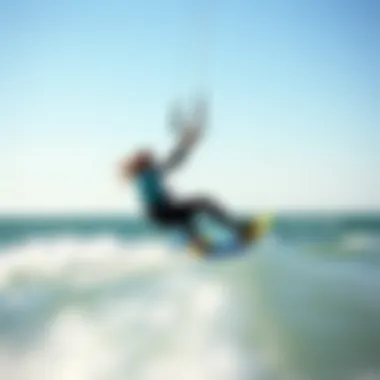
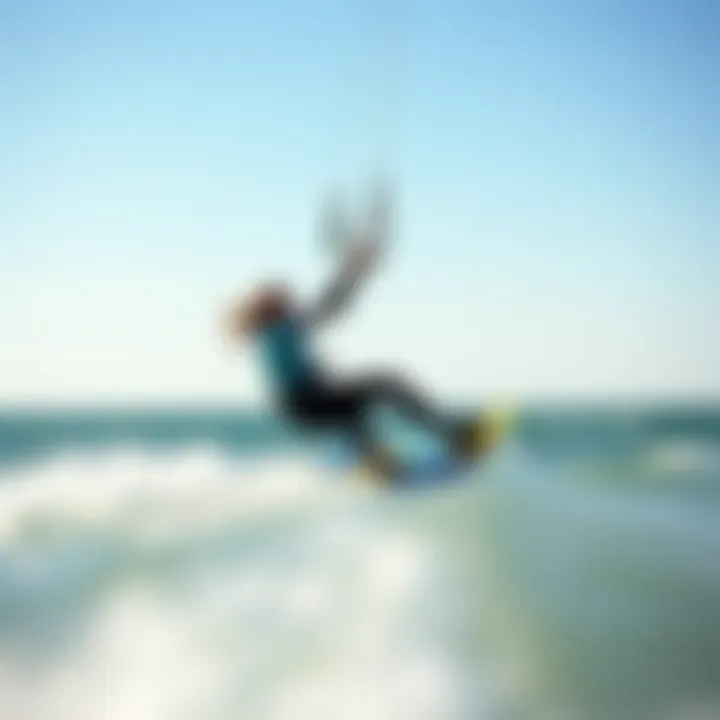
Mitigating risks is all about proactive planning and smart practice. Here are some best practices to keep in mind for safe foil wing riding:
- Wear Appropriate Safety Gear: Always don a personal flotation device, helmet, and potentially even impact vests. When you’re out on the water, these items can provide that extra layer of security.
- Pre-Ride Checks: Before hitting the water, examine your gear thoroughly. Ensure that your lines are in good condition, the wing is free of damage, and that you know how to operate the equipment.
- Stay Aware of Others: Maintain a good view of what's happening around you, be it fellow kiteboarders, swimmers, or other watercraft. Always keep at a safe distance.
- Choose the Right Conditions: Don't bite off more than you can chew. Beginners should avoid extreme wind conditions or crowded beaches until they are comfortable with their foil wings. Choose a spot where you can ride safely.
- Invest in Quality Gear: Opt for respected brands like Liquid Force. Quality equipment is less likely to malfunction and can withstand the rigors of extreme conditions better.
By keeping these considerations in mind, kiteboarders can significantly increase their safety while still enjoying the exhilarating sensation of flight.
Maintenance and Care for Foil Wings
Taking care of your Liquid Force foil wings is more than just a good idea; it's an essential part of maximizing their lifespan and maintaining performance. Just like any piece of sporting equipment, neglecting maintenance can lead to diminished returns and increased risks of accidents. Foil wings, given their unique construction and exposure to the elements, require attention to detail when it comes to cleaning, storage, repair, and overall care. In the long run, proper maintenance ensures that you get every ounce of thrill from your kiteboarding adventures while safeguarding your investment.
Cleaning and Storage Techniques
After a day on the water, the joy of kiteboarding can sometimes get overridden by the labor of cleaning and storing your foil wings. However, this process is crucial for retaining performance and appearance. Here are a few steps worth adopting:
- Rinse Off Salt Water: It’s a no-brainer, but often overlooked. After each session, make sure to thoroughly rinse your wings in fresh water. Salt residue can deteriorate materials over time, leading to corrosion and damage.
- Use Mild Soap: If your gear is particularly dirty, consider using a mild soap. Scrubbing with a soft cloth or sponge will help remove any stubborn grime without damaging the surface.
- Dry Completely: It’s essential to let your foil wings dry completely before you store them. A damp wing in a closed space can foster mold and mildew growth which could ruin the wings.
- Store Upright: When it comes to storage, keeping your wings upright, preferably in a dedicated bag or on a rack, helps maintain their structural integrity. Compressing and folding can lead to creases that might impact performance.
- Avoid Direct Sunlight: Whether it’s in transit or in storage, avoid leaving your wings in direct sunlight for prolonged periods. UV rays can break down the materials, causing them to weaken over time.
Repair and Troubleshooting
Despite your best efforts, accidents do happen, and knowing how to address them is part of responsible foiling. Here are some common issues one might encounter and solutions to consider:
- Small Dings or Scrapes: These can be handled with repairs using specialized repair kits designed for fabric and sealant. Make sure to follow the manufacturer’s guidelines for effective repairs. A quick fix can save you from larger problems later.
- Seam Issues: If you notice some loose stitches along seams, don’t ignore it. A simple needle and thread can do wonders. Reinforcing these areas will prevent bigger rips down the line.
- Wing Material Tears: For larger tears, it is advisable to reach out to professionals. Trying to repair this type at home can lead to subpar results. Just like a bad haircut, it’s often best to let the experts handle it.
"A stitch in time saves nine."
In kiteboarding, this time-tested wisdom certainly rings true. Regular checks, routine maintenance, and prompt repairs will keep your Liquid Force foil wings in top shape.
Maintaining your foil wings may sound mundane, but it’s a necessary step that pays off greatly. Taking the right steps will not only enhance your sessions but will also provide peace of mind. For more tips on gear maintenance in kiteboarding, you can check resources like Kiteforum or safety guidelines shared by industry experts at IKSurfMag.
By investing a little time in care and maintenance, you’re investing in your kiteboarding experience.
Future Trends in Foil Wing Technology
As kiteboarding continues to evolve, the dynamics of the sport are heavily influenced by advancements in foil wing technology. Understanding these future trends is crucial not only for kiteboarders but also for manufacturers, instructors, and anyone involved in water sports. The innovations currently on the horizon promise to enhance performance, create more responsive designs, and ensure sustainability—addressing the needs of an increasingly eco-conscious community while pushing performance boundaries.
Focusing on these developments can help enthusiasts choose the right gear, stay competitive, and even contribute to the discussions on best practices to promote environmental health in the sport.
Innovations on the Horizon
The kiteboarding industry is buzzing with excitement over new innovations set to redefine the capabilities of foil wings. Some anticipated advancements include:
- Smart Materials: Engineers are experimenting with materials that can alter their characteristics based on environmental conditions. This means foil wings could change rigidity or respond to water and wind dynamics automatically, providing optimal performance without requiring constant manual adjustments.
- 3D Printing Technology: Companies are beginning to explore the use of advanced manufacturing techniques such as 3D printing for creating custom foil wings. This method not only allows for intricate designs but also reduces material waste, offering a more efficient production process that can lead to lower prices for consumers.
- Modular Designs: Kaboboards can increasingly benefit from modular wing designs allowing riders to mix and match components for personalized experiences. These customizable wings cater to different levels of skill and sailing conditions, enabling novices to find their footing while giving seasoned riders the ability to tweak their setup.
These emerging innovations are races ahead, weaving technology into the fabric of kiteboarding that reshape the landscape of what’s possible on the water.
Sustainability in Kiteboarding Gear
As concern about environmental issues continues to grow, the kiteboarding community is also looking to make strides towards sustainability. The push for eco-friendly solutions is no longer a singular effort but involves various stakeholders from brands to consumers. Here are some focused considerations that are gaining traction:
- Biodegradable Materials: Manufacturers are actively seeking materials that break down naturally, minimizing the long-term impact on the environment. By using organic composites or materials derived from plants, the industry can fulfill performance needs while being kinder to our oceans.
- Energy-efficient Production: Some companies are computing their carbon footprint by streamlining production processes as well as investing in renewable energy sources. Approaches like harnessing solar or wind energy could be pivotal in revolutionizing how gear is produced.
- Recycling Initiatives: The newest trends also involve take-back programs, where manufacturers offer incentives for returning used gear. This not only promotes recycling but also keeps kiteboarding enthusiasts engaged in the product lifecycle, creating a stronger community ethos focused around sustainability.
The importance of approaching future developments with a lens of sustainability can enhance the sport’s image and align it with broader global initiatives aimed at preserving our playfield—our precious oceans.
"As technology advances, we must ensure that our passion for adventure does not come at the cost of our environment."
Investigating these trends not only prepares kiteboarders but also enriches the overall conversation surrounding our responsibilities as stewards of the waterways we cherish.
Closures and Key Takeaways
In concluding the discussion on Liquid Force foil wings in kiteboarding, it becomes clear that these innovations have dramatically reshaped the experience for riders at all levels. The advancements in design and technology not only enhance performance but also provide valuable insights into the nuances of water dynamics. As kiteboarding continues to evolve, understanding the interplay of material choices, wing construction, and hydrodynamics is crucial for anyone looking to optimize their riding experience.
Summarizing the Benefits and Considerations
Liquid Force foil wings offer a plethora of advantages:
- Efficiency: Their design significantly reduces drag, allowing for swifter glides and improved overall speed. This becomes especially noticeable during light wind conditions, where these wings truly shine.
- Stability: The enhanced stability provided by the foil design ensures even beginners can maintain control, reducing the learning curve without compromising excitement.
- Adaptability: Riders can perform in various wind conditions, from gentle breezes to stronger gusts, making these wings versatile tools for exploration on the water.
On the flip side, there are considerations that kiteboarders must keep in mind:
- Learning Curve: For newcomers, switching to foil wings can pose a steeper learning curve compared to traditional kites. Mastery of balance and technique is essential.
- Maintenance: Regular upkeep is needed to ensure longevity and performance. Understanding the specifics of cleaning, storing, and repairing these wings is non-negotiable.
- Safety: As with any water sport, awareness of safety practices is paramount. Understanding the risks associated with foil wings, such as potential injuries from high speeds or crashes, is part of responsible riding.
"Liquid Force has redefined what kiteboarding can be; not just a sport, but a fluid dance with nature."
Encouraging Continued Exploration
The adventure does not end with the current understanding of Liquid Force foil wings. Kiteboarding is a field ripe for ongoing discovery, and embracing new technologies will only enhance the thrill. Riders are encouraged to:
- Experiment: Find which wing designs best suit individual riding styles. The diversity in Liquid Force offerings means there’s likely a perfect fit for every rider.
- Stay Informed: Follow trends in kiteboarding innovation through specialized forums or events. Websites like reddit.com often feature discussions that can provide insights into personal experiences with equipment.
- Connect with Community: Engage with fellow kiteboarders, whether at local spots or online. Sharing knowledge about gear, techniques, and riding conditions enriches the sport for everyone involved.
In essence, the journey with Liquid Force foil wings unfolds with each ride. As kiteboarders delve deeper into their potential, the harmony between rider and nature becomes even more palpable, leading to exhilarating and transformative experiences on the water.






